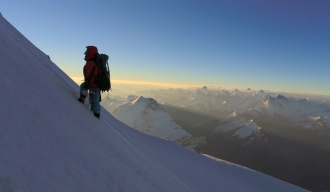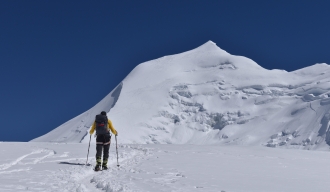SATOPANTH (7075m)
SATOPANTH (7075m)
India
- 27 DAYS
- 12 MAX GROUP SIZE
-
7075m
MAX ALTITUDE  9
Very Demanding
9
Very Demanding
Trip leader

324000 / 5900
Trip costSatopanth in the local dialect literally means ‘true path’. It is the second-highest mountain in the Gangotri group in Uttarakhand and is quite a formidable undertaking. It makes for a compelling proposition to mountain junkies, willing to make the transition from ‘trekking’ peaks to ‘climbing’ peaks and experience the high alpine environment at 7,000m+!!
The route includes a complex glacier approach, high-angled snow slopes and knife edge ridge, before the final section to the summit. At just over 7,000m, the effect of high altitude is a significant factor, as is the remote location and possibility of extreme weather. Mt. Satopanth serves as a good introduction to technical climbing, with climbers being exposed to the use of crampons, fixed ropes and jumar climbing. Many Indian expeditions going to climb Mt. Everest or other 8,000m+ peaks climb Mt. Satopanth as a preparatory trip.
Itinerary
Trip Cost
324000 / 5900
DELHI TO DELHI , TWIN SHARINGPayment Schedule
₹75000 / $1500 - Booking Amount
TRIP COST INCLUDES
- All airport/ railway station transfers
- All land transport of members and support team as per the itinerary above
- All accommodation on the trek on twin sharing basis
- - All meals on the trek (except Delhi hotel on bed & breakfast basis)
- - Services of a guide, sherpas/ high altitude porters (HAPs) on the mountain; cook & an assistant till base camp.
- - Group climbing gear (Ropes, Anchors, Shovels, Slings etc)
- - Kitchen, Dining Tent & Toilet tent till Base Camp
- - North Face / Ozark or Mountain Hardwear tents for the climb
- - Climbing Permits
- - Uttarakhand State Royalty Fee
- - Laison Officer’s Fee to the IMF and all expenses incurred for his food, lodging & travel.
- - Porterage of all the equipment / supplies/ & personal baggage of max 20 kgs per member to & from Base Camp.
- - GST as applicable (Subject to change as per govt rules).
TRIP COST EXCLUDES
- - Any sightseeing etc in Delhi
- - Individual Climbing Gear
- - Sleeping Bag & items of personal clothing
- - Any costs arising from early departure from the expedition.
- - Any extra costs incurred caused in the event of finishing the expedition early.
- - Expenses of personal nature like laundry, phone calls, beverages, insurance & tips.
- - Any costs arising out of unforeseen circumstances such as bad weather, landslides, road conditions and any other circumstances beyond our control.
- - Tips for porters, guides, sherpas etc.
- Note -
- Single Room in Hotels can be booked at an additional cost.
Cancellation terms
If it becomes necessary to cancel your trip, you must notify the office immediately in writing. The following terms would be applicable.
• If you cancel more than 60 days prior to departure, we will charge 10% of the trip cost as cancellation fee and refund the balance.
• If you cancel less than 60 days prior to departure, we will charge 25% of the trip cost as cancellation fee and refund the balance.
• If you cancel less than 45 days prior to departure, we will charge a 50% cancellation fee and balance amount would be held as a credit towards a future trip taken within 1 year from the date of cancellation.
• If you cancel less than 30 days prior to departure, the entire deposit would be forfeited.
The tour price is quoted as a package. No partial refunds or credit will be given for services not used. We recommend that you obtain cancellation travel insurance upon booking. If you can replace your spot by getting someone else to take that seat cancellation charges would be waived completely.
Pls note that these cancellation terms may be amended from time to time.
What to expect
A climbing expedition to a peak above 7000m is considered a very demanding climb. The peaks pose great physical and technical challenge due to altitude, terrain and the cold temperatures. A typical expedition to a 7000m peak will need 3 camps to be established above base camp. You will need to carry your personal gear upto the summit camp which goes through technical terrain, making it physically demanding. Altitude has a great effect on this trip so we give a lot of stress to acclimatizing well and take great care while planning our itineraries. 7000m peaks are an ideal step-up for anyone who has done demanding climbs and are trying to prepare for an 8000m expedition.
A fierce determination and a burning desire to climb the mountain are the essential pre-requisites for joining this expedition. One must have done a few high altitude treks and must have climbed some glaciated peaks above 6000m. One needs to be familiar with walking in snow and ice and must have a good standard of fitness. You should be familiar with Ice Axe arrest and crampon skills, the use of ascenders (jumar) and descenders, and how to use your particular harness.
You have full support till base camp which means you only carry a back pack till BC. We encourage climbers to carry a little more weight than just a back pack as it helps higher up on the climb but it is optional. Above base camp the sherpa team puts all the fixed ropes and hauls all the common gear - food, fuel, tents etc
All climbers are expected to carry all their personal gear with them - climbing eqpt/ clothing/ sleeping bag/ mattress etc. We also do a couple of load ferries on the way up. On the way down we normally bring it all in one go.
At high camps - Food & water is prepared by the guides & sherpa team. If someone wants to help with shoveling snow/ pitching tents etc he/ she is welcome but again it is optional.
Having very high fitness levels is essential and climbers would need to train considerably for these climbs.
Besides being physically fit and having the climbing skills, you need to have the proper attitude and mental discipline. You will need to be willing to work hard day after day, with no comforts. You may need to dig deep into your reserves after a long day of climbing in bad weather to help set up camp,help a team member. organise your tent, change into dry clothes and be ready for another such day.We would be melting snow to make water at high camps (5-6 days) and will have simple food to survive on.
Apart from the mental strength having a positive attitude and the ability to get along well with strangers in stressful situations is very important. You would be sharing a lot of time with your tent partners especially if we are waiting out bad weather. Having good manners and hygiene would be important. Everyone must learn patience and relax! At high camps tou could be paired up with a person of a different gender and hence you could be required to give even more private time & spaceto your tent mate.
7-10 days on the mountain would be very demanding but high motivation can overcome most of the difficulties. Waiting out storms and bad weather is quite difficult, especially at high altitude. Everyone must learn patience and relax!
Some weight loss is inevitable
If you are not prepared, you may not be allowed to continue the climb.


